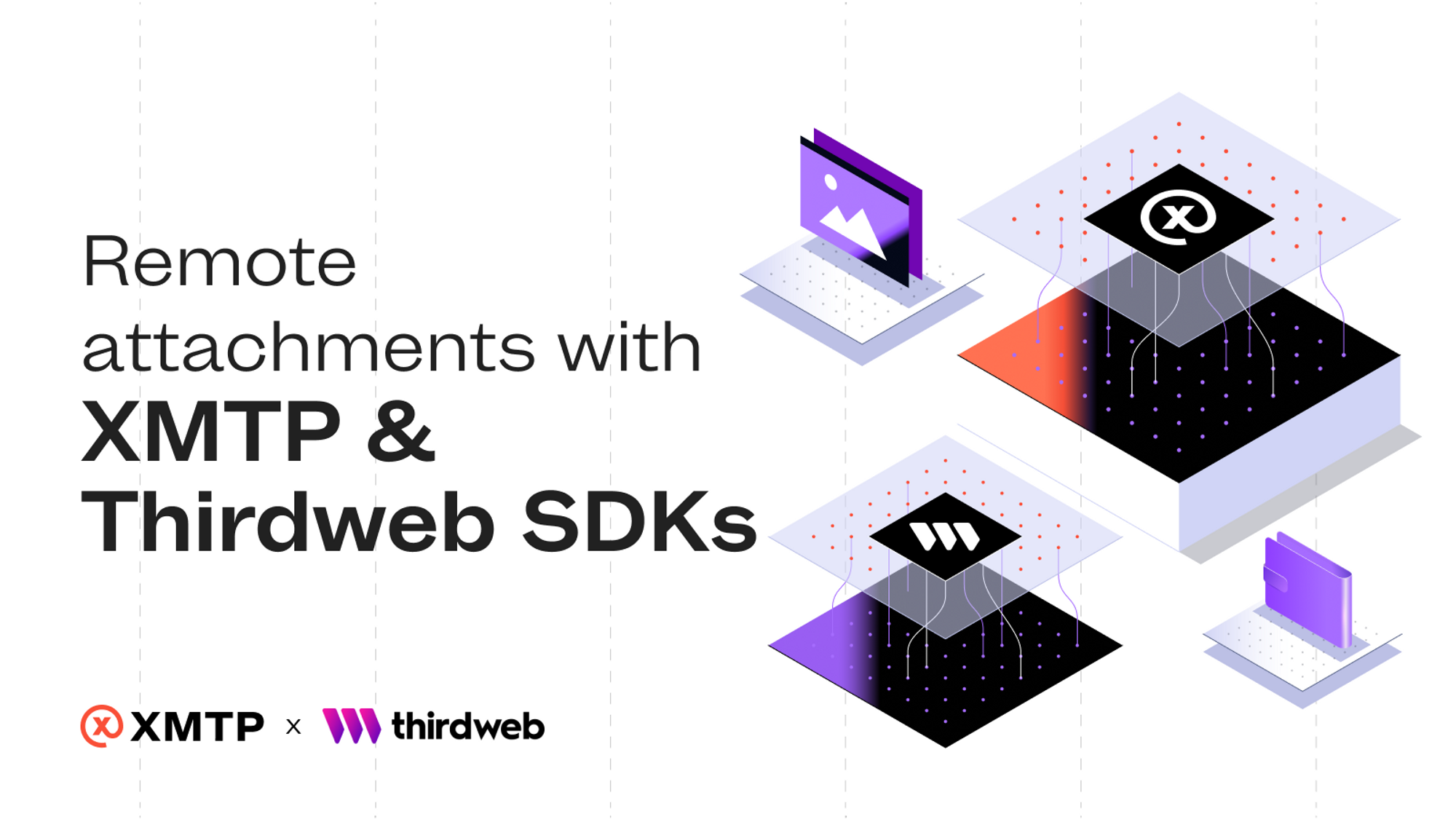This post may be out of date. See the Attachments tutorial for the latest guidance on how to build attachments.
Follow these steps to start sending image attachments to wallets within your chat app. Our sample app includes everything you need to connect to wallets with Thirdweb's WalletSDK, use XMTP's remote attachments, and upload larger files to Thirdweb's storage.

Concepts
Thirdweb WalletSDK
The WalletSDK is a development kit that grants developers access to a comprehensive selection of wallets, ranging from custodial to MPC to smart contracts. Read more
XMTP content types
Content types are a way to describe the type of content a message contains on XMTP. Out of the box, XMTP's SDKs support one content type: text.
Read more
Thirdweb storage
StorageSDK handles the complexities of decentralized file management for you. No need to worry about fetching from multiple IPFS gateways, handling file and metadata upload formats, etc. Read more
Demo app
This repository demonstrates the implementation of these concepts within a simple chat app.
git clone [email protected]:xmtp/xmtp-quickstart-thirdweb.git
cd xmtp-thirdweb-js
npm install
npm run dev
Learning objectives
- Connect wallet button
- Signing in with XMTP
- Loading a conversation
- Sending a message
- Sending a remote attachment
- Receiving attachments
Get started
The first step involves creating and configuring the Next.js application.
To generate a new Next.js app, execute the following command in your terminal:
npx create-next-app xmtp-thirdweb
✔ Would you like to use TypeScript with this project? Yes
✔ Would you like to use ESLint with this project? Yes
✔ Would you like to use Tailwind CSS with this project? Yes
✔ Would you like to use `src/` directory with this project? No
✔ Use App Router (recommended)? Yes
✔ Would you like to customize the default import alias? No
Next, navigate into the newly created directory and install the necessary dependencies for using XMTP and Thirdweb:
npm install @thirdweb-dev/react @thirdweb-dev/sdk @xmtp/xmtp-js xmtp-content-type-remote-attachment
Set up the ConnectWallet button

Begin by wrapping the app with ThirdwebProvider, then use the ConnectWallet component to establish wallet connectivity.
<ThirdwebProvider activeChain="goerli">
<Home />
</ThirdwebProvider>
//Just one line of code to connect to wallet
<ConnectWallet theme="light" />
//After logging in, we can use thirweb hooks to see the wallet
const address = useAddress();
const signer = useSigner();
That’s it! Next, proceed with signing in to XMTP.
Sign in with XMTP

Create a new XMTP instance and register the content types your chat app will utilize.
// Function to initialize the XMTP client
const initXmtp = async function () {
// Create the XMTP client
const xmtp = await Client.create(signer, { env: "dev" });
// Register the codecs. AttachmentCodec is for local attachments (<1MB)
xmtp.registerCodec(new AttachmentCodec());
//RemoteAttachmentCodec is for remote attachments (>1MB) using thirdweb storage
xmtp.registerCodec(new RemoteAttachmentCodec());
//Create or load conversation with Gm bot
newConversation(xmtp, PEER_ADDRESS);
// Set the XMTP client in state for later use
setXmtpConnected(!!xmtp.address);
//Set the client in the ref
clientRef.current = xmtp;
};
Load a conversation
In this case, we will use our GM Bot and the XMTP instance to create the conversation. If the conversation already exists, it will retrieve its message history.
const newConversation = async function (xmtp_client, addressTo) {
//Checks if the address is on the network
if (xmtp_client.canMessage(addressTo)) {
//Creates a new conversation with the address
const conversation = await xmtp_client.conversations.newConversation(
addressTo,
);
convRef.current = conversation;
//Loads the messages of the conversation
const messages = await conversation.messages();
setMessages(messages);
} else {
console.log("cant message because is not on the network.");
//cant message because is not on the network.
}
};
Send an attachment
Text messages require neither codec nor encryption. They can be sent as they are.
const onSendMessage = async (value) => {
return convRef.send(value);
};
Attachments smaller than 1MB can be sent using the AttachmentCodec. The codec will automatically encrypt the attachment and upload it to the XMTP network.
// Function to handle sending a small file attachment
const handleSmallFile = async (file) => {
// Convert the file to a Uint8Array
const blob = new Blob([file], { type: file.type });
let imgArray = new Uint8Array(await blob.arrayBuffer());
const attachment = {
filename: file.name,
mimeType: file.type,
data: imgArray,
};
await conversation.send(attachment, { contentType: ContentTypeAttachment });
};
Send a remote attachment
Attachments larger than 1MB can be sent using the RemoteAttachmentCodec. The codec will automatically encrypt the attachment and upload it to the Thirdweb network. For uploading bigger files, we are going to first encrypt them and then upload them to the IPFS network via the Thirdweb SDK.
- Encrypt the file
//Loadfile is a helper function to convert the file to a Uint8Array
const imgData = await loadFile(file);
const attachment = {
filename: file.name,
mimeType: file.type,
data: imgData,
};
const attachmentCodec = new AttachmentCodec();
const encryptedAttachment = await RemoteAttachmentCodec.encodeEncrypted(
attachment,
attachmentCodec,
);
- Next we are going to upload the file to the IPFS network via the Thirdweb SDK.
const uploadUrl = await upload({
//encryptedAttachment.payload.buffer is a Uint8Array
//We need to convert it to a File to upload it to the IPFS network
data: [new File([encryptedAttachment.payload.buffer], file.name)],
options: { uploadWithGatewayUrl: true, uploadWithoutDirectory: true },
});
//uploadUrl[0] is the IPFS hash of the encrypted file
uploadUrl[0];
- Finally, we will use the encrypted file's URL to send it to the XMTP network using XMTP
ContentTypeRemoteAttachment.
const remoteAttachment = {
url: uploadUrl[0],
contentDigest: encryptedAttachment.digest,
salt: encryptedAttachment.salt,
nonce: encryptedAttachment.nonce,
secret: encryptedAttachment.secret,
scheme: "https://",
filename: attachment.filename,
contentLength: attachment.data.byteLength,
};
const message = await conversation.send(remoteAttachment, {
contentType: ContentTypeRemoteAttachment,
});
Receive attachments
In the parent component, add a listener that will fetch new messages from a stream.
// Function to stream new messages in the conversation
const streamMessages = async () => {
const newStream = await convRef.current.streamMessages();
for await (const msg of newStream) {
const exists = messages.find((m) => m.id === msg.id);
if (!exists) {
setMessages((prevMessages) => {
const msgsnew = [...prevMessages, msg];
return msgsnew;
});
}
}
};
streamMessages();
Render these messages in the child component using a Blob for attachments.
if (message.contentType.sameAs(ContentTypeAttachment)) {
// Handle ContentTypeAttachment
return objectURL(message.content);
}
// Function to render a local attachment as an image
const objectURL = (attachment) => {
const blob = new Blob([attachment.data], { type: attachment.mimeType });
return (
<img
src={URL.createObjectURL(blob)}
width={200}
className="imageurl"
alt={attachment.filename}
/>
);
};
Remote storage is a different story because uploading and decrypting files is resource-consuming. We need to use the RemoteAttachmentCodec to decrypt the file and then render it. In the future, we will dive into performance improvements.
// This method receives the message.content as attachment, the xmtp client and the RemoteAttachmentCodec
export const deloadFile = async (attachment, client, RemoteAttachmentCodec) => {
return RemoteAttachmentCodec.load(attachment, client)
.then((decryptedAttachment) => {
console.log("attachment", decryptedAttachment);
// Create a blob URL from the decrypted attachment data
const blob = new Blob([decryptedAttachment.data], {
type: decryptedAttachment.mimeType,
});
return URL.createObjectURL(blob);
})
.catch((error) => {
console.error("Failed to load and decrypt remote attachment:", error);
});
};
export const loadFile = async (file) => {
return new Promise((resolve, reject) => {
const reader = new FileReader();
reader.onload = () => {
if (reader.result instanceof ArrayBuffer) {
resolve(new Uint8Array(reader.result));
} else {
reject(new Error("Not an ArrayBuffer"));
}
};
reader.readAsArrayBuffer(file);
});
};
That was easy! Now you can send and receive messages with attachments using XMTP and Thirdweb.
Join us on Discord
We're excited to partner with Thirdweb to bring you better solutions for serving and reaching your end users. Stay tuned for more guides coming soon!
Was the information on this page helpful?
powered by XMTP


